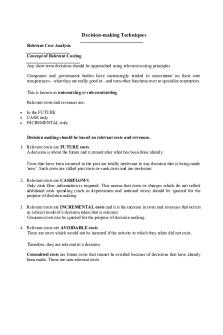Relevant Costing Notes PDF

| Title | Relevant Costing Notes |
|---|---|
| Course | Managerial Accounting I |
| Institution | Conestoga College |
| Pages | 4 |
| File Size | 312.2 KB |
| File Type | |
| Total Downloads | 61 |
| Total Views | 160 |
Summary
Chapter 11...
Description
Chapter 11: Relevant Information for Decision Making Chapter In Brief Managers make a variety of nonroutine operating decisions. These include special orders, outsourcing, keeping or dropping a product line, and constrained resource management. Costs are an important part of making these decisions. However, qualitative factors are also important, sometimes overriding cost considerations. Managers weigh a variety of quantitative and qualitative factors in choosing the best course of action.
Lecture Notes The decision process used for making nonroutine operating decisions
Distinguish between shorter term (decisions that are made periodically and that involve resources over a time period less than one year), and long-term capital budgeting decisions.
Similarities across different types of decisions: Contribution margin is a factor of focus Need to identify avoidable and unavoidable fixed costs
Make and buy, keep and drop have similar opportunity costs with regard to increased capacity if the product is outsourced of dropped. Take the action that maximizes current period income (or minimizes current period losses) To apply the general decision rule, identify and calculate relevant revenues and costs, such as: Contribution margin per unit Contribution margin per unit of constrained resource Fixed costs that differ across alternatives Opportunity costs The exhibit provides a good summary across decisions. Examples of Qualitative Factors
Keep or Drop Drop if contribution margin is less than the sum of relevant fixed costs and opportunity cost Only fixed costs that can be avoided if drop Opportunity Cost - Benefits from using released capacity for other purposes Make or Buy Outsource if buy cost is less than or equal to the sum of variable cost and relevant fixed costs minus opportunity cost Relevant Fixed Costs Only fixed costs that can be avoided if buy Opportunity Cost Benefits from using released capacity for other purposes Special Order General Decision Rule Accept if price is greater than or equal to the sum of variable cost, relevant fixed costs, and opportunity cost Relevant Fixed Costs Only new fixed costs associated with the special order Opportunity Cost Contribution margin of any regular business replaced Product Mix/Constrained Resource Managing constrained resources (types of decisions): Product emphasis Product mix when resources are constrained Relaxing constraints for two or fewer products Relaxing constraints for multiple products and multiple constraints General Decision Rule Product Emphasis: Emphasize product with highest CM per unit unless resources are constrained, then emphasize product with highest CM per unit of constrained resource Constrained Resource: Incur cost to relax constraint if cost is less than or equal to the sum of contribution margin per unit of constrained resource and the current variable cost of the resource Relevant Fixed Costs Constrained Resource: Only new fixed costs to relax the constraint Qualify of Operating Decisions Quality of Information Uncertainties
Information timeliness Analysis technique assumptions Managers would like to maximize short-term profits CVP assumptions (see Chapter 3) Additional assumptions for constrained resource decisions: The organization will forego sales if the resource constraint is not relaxed The constraint arises after the point in the operating cycle when fixed costs have already been covered by regular sales Sales of one product do not affect sales of other products Quality of Decision Process Decision maker bias Sensitivity analysis Prioritization Examples of Business...
Similar Free PDFs

Relevant Costing Notes
- 4 Pages

Relevant Costing
- 6 Pages

Relevant Costing
- 28 Pages

Relevant Costing - Lecture notes 1
- 13 Pages

Relevant-Costing-Analysis
- 11 Pages

Lesson 2 Relevant Costing
- 20 Pages

Chapter-10-relevant costing
- 37 Pages

MSQ 05 Relevant Costing
- 12 Pages

05-Relevant Costing & CVP
- 21 Pages

Answers Relevant Costing
- 39 Pages
Popular Institutions
- Tinajero National High School - Annex
- Politeknik Caltex Riau
- Yokohama City University
- SGT University
- University of Al-Qadisiyah
- Divine Word College of Vigan
- Techniek College Rotterdam
- Universidade de Santiago
- Universiti Teknologi MARA Cawangan Johor Kampus Pasir Gudang
- Poltekkes Kemenkes Yogyakarta
- Baguio City National High School
- Colegio san marcos
- preparatoria uno
- Centro de Bachillerato Tecnológico Industrial y de Servicios No. 107
- Dalian Maritime University
- Quang Trung Secondary School
- Colegio Tecnológico en Informática
- Corporación Regional de Educación Superior
- Grupo CEDVA
- Dar Al Uloom University
- Centro de Estudios Preuniversitarios de la Universidad Nacional de Ingeniería
- 上智大学
- Aakash International School, Nuna Majara
- San Felipe Neri Catholic School
- Kang Chiao International School - New Taipei City
- Misamis Occidental National High School
- Institución Educativa Escuela Normal Juan Ladrilleros
- Kolehiyo ng Pantukan
- Batanes State College
- Instituto Continental
- Sekolah Menengah Kejuruan Kesehatan Kaltara (Tarakan)
- Colegio de La Inmaculada Concepcion - Cebu





